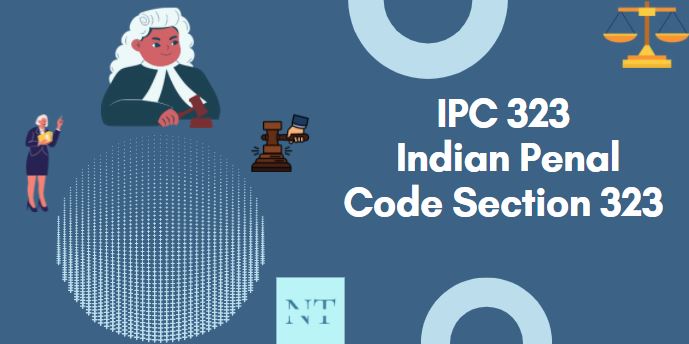IPC 323: The punishment for intentionally causing harm is outlined in Section 323 of the IPC. “Whoever intentionally hurts another must be penalized with imprisonment of the description given for a time. This might extend to a year, or by a fine which might also reach to one thousand rupee, or with both,” according to the provision. To fully comprehend section 323 IPC, it is required to grasp phrases such as “hurt,” “voluntarily inflicting harm,” and “what is covered in this provision and which components are omitted.”
Table of Contents
What Constitutes Hurt?
Hurt typically refers to non-fatal offences that often do not result in anyone’s death. A person can conduct non-fatal offences towards society or a person in a variety of ways, including as causing serious body injury, property destruction, or infecting anybody with a dangerous disease. The damage is occasionally reversible, but even though more of the time it is irreversible. As a result, it is critical to be aware of the violations involving Section 323, i.e. intentionally inflicting harm to another person, as well as the punishments provided by the Indian Penal Code.
What does Voluntarily Causing Hurt Mean?
Section 321 of the IPC defines the word “voluntarily causing hurt.” As per this section, a person who causes harm or he knows that his activity will cause harm to another person and continues to do just that is said to have committed the crime of Voluntarily inflicting harm.
In this case, if a person did cause bodily discomfort, sickness, or disability to another person. As a result, a person who willfully causes any form of harm to someone, and who understands that his conduct would cause harm to that person, would be held guilty for the conduct of Voluntarily inflicting harm.

Essential Ingredients of Hurt under Section 323
So by now, it is clear that for an offence to be punishable under section 323, the hurt should consist of either:
- Bodily harm
- Disease
- Disorder
- Bodily Harm
As per Section 319 of said Indian Penal Code, anybody who causes bodily pain, disturbance, or disease to someone is considered to be hurting them. The term ‘physical pain’ implies that the agony must be physical rather than mental. As a result, injuring someone psychologically or emotionally would no longer be considered “harm” under Section 319. Nonetheless, it is not necessarily necessary for any apparent harm to occur at the suffering in order to be protected under this rule.
In the case of State vs. Ramesh Dass, on May 22, 2015, while travelling through a hospital hallway in the advanced surgical block site, an unknown public figure approached the woman at the front and assaulted her. That person grabbed her hair and tossed her towards the ground. With his arm, he struck her on the head. Accused was found guilty of Sections 341 and 323 of the Indian Penal Code and acquitted of Section 354 of the Code.
- Disease
Hurt would result from the transmission of an illness or disease from a person to another by contact. However, the concept is dubious when it comes to the transfer of sexual diseases from one person to another.
For example, in the case of Raka v. Emperor, a prostitute who already had intercourse with the person and therefore transmitted syphilis was charged and Convicted under 269 of the IPC for infection transmission rather than inflicting harm since the time between the conduct and the illness was too long to trigger Section 319 of the IPC.
- Disorder
A condition of transitory intellectual impairment, hysteria, or dread would be considered sickness under the meaning of this phrase in the section. It is an organ’s inability to perform its normal functions, whether temporarily or permanently. It can be provided by the ingestion of a harmful or dangerous chemical or through the ingestion of alcohol administered by someone else.
In the case of Jashanmal Jhamatmal vs Brahmanand Swarupanand AIR 1944 Sind 19, the respondent was evicted with the owner’s help in this case. He tries to avenge himself by evacuating others from the building as well. Respondent was then challenged by A’s spouse, who was holding a gun.
Landmark Judgements
- Ayoub Dedar v State of J&K, 2010 Cr LJ 2497 (JK)
With both hands, the first accused grabbed up a wooden object (Pacher) and slammed it into the deceased’s skull. He was knocked out on the spot after being injured. Following that, the other accused dashed forward and struck PW3 in the head. The conviction of the first accused with section 304 Part II and the co-accused with section 323 of the Indian Penal Code, 1860, was upheld.
- State of Maharashtra v Tatyaba Bajirao Jadhav, 2011 Cr LJ 2717 (Bom).
When the accused walked into the house of the complainant with sticks in the hands and physically attacked him, the explicit act pertaining to accused by witness testimony is particular, clinical evidence strongly supports the prosecution’s case, and the accused/respondent is subject to liability to be found guilty under section 323 of the IPC, 1860.
- PP v NS Murthy, 1973 Cr LJ 1238 (AP)
In a violent disagreement, the accused, a shopkeeper, struck his wife in the head with a 200-gram iron hammer, killing her. The medical data indicated that the damage was minor, since there was no proof that the dead died as a result of the injury’s shock. He was found guilty solely under section 323 of the Indian Penal Code, 1860, but not against section 304 of the same code.
- Sellamuthu v State of TN, (1995) 2 Cr LJ 2143 (Mad)
The defendant shoved the victim. She was knocked down and suffered minor injuries. The accused’s actions were found to be in violation of section 323.
- Pichapillai v State of TN, 1996 Cr LJ 3634 (Mad)
Conviction was registered under section 323, in which the accused pushed the deceased’s chest as well as the victim landed on a stone, ending in death.
- Shyamji v State of Rajasthan, 1993 Cr LJ 2458 (Raj)
At midnight, the alleged husband arrived home inebriated. He thrashed his wife and flung a stone at her, killing her. The post-mortem analysis found three minor head injuries, but the specific cause of death was unknown. The accused’s relationship with the dead was deemed to be friendly. It was not proven that the defendant intended to kill the victim. The accused’s conviction under section 300 was overturned, and he was found guilty under section 323.
- Mohan Singh v State of Rajasthan, 1994 Cr LJ 2229 (Raj)
The accused in Mohan Singh vs State of Rajasthan attacked his victim and inflicted voluntary harm to him by striking him with fists and injuring his nose. The testimony of the witnesses showed his guilt. The accused’s claim of alibi proved untrue. His punishment under Section 323 of the Indian Penal code was affirmed.
Additional Information
Knowingly and willingly causing hurt is a non-cognizable offence, which means that if someone commits an offence under this provision, the police cannot arrest them without a warrant. An offence within this provision is bailable and is subject to investigation and decision by the Magistrate who has jurisdiction over the area where the offence occurred. When it comes to inflicting harm on another person, knowing what you’re doing is crucial. A person is considered to have caused harm too if he sets out to purposely shock someone with a weak heart and accomplishes in doing so.
Suggested Reading:
| Go To Sundarban News Today’s Home Page | Click Here |
| Go To Supreme Court’s Judgement | Click Here |
| Article Category | Legal Guide |
